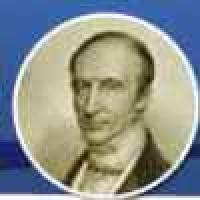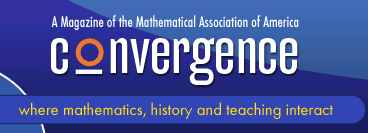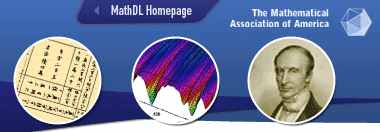
Convergence: Where Mathematics, History and Teaching Interact

The Mathematical Association of America (MAA) has developed a new online magazine, intended as a resource for maths teachers. The Editor Victor Katz explains.
Convergence: Where Mathematics, History and Teaching Interact is the MAA's new online magazine in the history of mathematics and its use in teaching. Part of MathDL, the mathematics digital library, Convergence is a resource and forum for mathematics teachers of high school classes and lower division classes who want to use the history of mathematics to engage and motivate their students and help them better understand the mathematical ideas. The editors, Victor J. Katz, from the University of the District of Columbia, and Frank Swetz, from Penn State University, Harrisburg, welcome all members to log in to the Convergence website and see what the magazine has to offer.
Among the types of material appearing in the magazine are the following:
- Expository articles dealing with the history of various topics in the mathematics curriculum. These may contain interactive components and colour graphics, to take advantage of the capabilities of the Web. Each article will have a discussion group attached, where readers can share suggestions as to how the material can be used in the classroom and point out strong points and possible pitfalls.
- Translations of original sources, generally accompanied by commentary showing the context of the works. The goal of these translations is always to show teachers how ideas were developed in various cultures and how knowledge of this development is useful to teaching the same ideas to today's students.
- Reviews of current and past books, articles, and teaching aids on the history of mathematics of use to teachers, as well as reviews of websites providing information on the history of mathematics.
- Classroom suggestions. These may be self-contained articles showing how to use history in the teaching of a particular topic or they may be materials closely related to a main article, showing in some detail how to use the article in a classroom setting.
- Historical problems. These problems will appear in a section entitled "Problems from another time," with new problems appearing frequently.
- What Happened Today in History? Each day, there will be a listing of 2-3 "mathematical events" which happened on that date in history.
- Quotation of the day. A new and interesting quotation about mathematics from a historical figure will appear in this section each day. The reader will also be able to search our database of quotations to find additional ones.
- An up-to-date guide to what is happening around the world in the history of mathematics and its use in teaching. The magazine will report on past meetings and give notice of future meetings. Where abstracts are available for a particular meeting, these will be included. We may also include copies of handouts for easy access, as well as links to the author's webpage, if available.

The magazine is currently free to all, due to the support of the National Science Foundation, but registration is required to access the site. A small subscription fee will be charged beginning later this year.
Currently, we have a limited supply of articles in our pipeline. Because our goal is to bring out new material on a regular basis, we need a continual flow of articles and classroom suggestions. We therefore welcome your ideas for articles as well as your completed manuscripts. In particular, we welcome short classroom suggestions that can immediately be implemented by teachers. Materials should be sent both in hardcopy and electronically. Hardcopy should be sent to
Victor Katz
Convergence
Mathematical Association of America
1529 18th St. N.W.
Washington
DC 20036.
USA